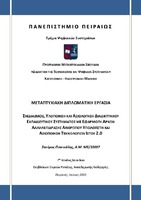Σχεδιασμός, υλοποίηση και αξιολόγηση διαδικτυακού εκπαιδευτικού συστήματος με εφαρμογή αρχών αλληλεπίδρασης ανθρώπου υπολογιστή και αξιοποίηση τεχνολογιών ιστού 2.0

Προβολή/
Θεματική επικεφαλίδα
Εκπαιδευτική τεχνολογία ; Εκπαίδευση -- Πληροφορική ; Αλληλεπίδραση ανθρώπου-υπολογιστή ; Web services ; Διαδίκτυο (Internet) στην εκπαίδευση ; Ανάλυση και σχεδίαση συστημάτωνΠερίληψη
Στην εποχή της τεχνολογικής και ψηφιακής επανάστασης, οι Τεχνολογίες Πληροφορίας και Επικοινωνιών (ΤΠΕ) κατέχουν κυρίαρχο ρόλο και επηρεάζουν όλους τους τομείς της ανθρώπινης δραστηριότητας, συμπεριλαμβανομένης και της εκπαίδευσης. Η ανάπτυξή τους έχει τροποποιήσει σε σημαντικό βαθμό τη φύση και τα χαρακτηριστικά της εκπαιδευτικής και μαθησιακής διαδικασίας και έχει καθιερώσει την εξ αποστάσεως εκπαίδευση ως εναλλακτική μορφή εκπαίδευσης, που υποστηρίζεται από νέες τεχνολογίες και εφαρμογές, όπως αυτές του Ιστού 2.0 (Web 2.0). Σημαντικός είναι ο ρόλος των Εκπαιδευτικών Συστημάτων και ιδιαίτερα των Διαδικτυακών, τα οποία προσδίδουν νέες προοπτικές στην εκπαίδευση και τη δομή του εκπαιδευτικού περιβάλλοντος, καθώς μπορούν να αποτελέσουν ουσιαστικό εργαλείο τόσο στα χέρια των εκπαιδευτικών όσο και στα χέρια των εκπαιδευόμενων, αλλά και των υπόλοιπων συμμετεχόντων στην εκπαιδευτική διαδικασία (γονείς, εκπαιδευτικοί φορείς κ.λπ.). Βασική προϋπόθεση της αποτελεσματικότητάς τους είναι ο σχεδιασμός με εφαρμογή βασικών αρχών Αλληλεπίδρασης Ανθρώπου-Υπολογιστή, σε συνδυασμό με σύγχρονες θεωρίες μάθησης. Παρά το γεγονός, πως το πεδίο της Αλληλεπίδρασης Ανθρώπου-Υπολογιστή (ΑΑΥ), παρουσιάζει σημαντικά ερευνητικά αποτελέσματα, σχετικά με παραμέτρους αποτελεσματικής σχεδίασης, όπως η ευχρηστία, η διεπαφή, η απεικόνιση στοιχείων κ.λπ., πολλές φορές αυτά δεν αξιοποιούνται κατά το Σχεδιασμό ενός συστήματος. Πρέπει να επισημανθεί ότι, οι διαφορές ενός ΔΕΣ συγκριτικά με άλλες εφαρμογές, όπως βιομηχανικές, αυτοματισμού κ.α., στις οποίες εστιάζεται το ενδιαφέρον στο πεδίο της ΑΑΥ, είναι σημαντικές. Το στιλ αλληλεπίδρασης, που χρησιμοποιείται σε ένα ΔΕΣ, παρουσιάζει ιδιαιτερότητες σε σχέση με τα στιλ αλληλεπίδρασης που ερευνώνται στην ΑΑΥ, με άξονα αναφοράς τυπικούς χρήστες σε διαφορετικά περιβάλλοντα εργασίας. Στα ΔΕΣ, ζητούμενο αποτελεί η μάθηση και όχι η απλή διεξαγωγή μιας συγκεκριμένης διεργασίας, της οποίας οι βασικές αρχές που τη διέπουν είναι ήδη γνωστές στον τελικό χρήστη. Ο εκπαιδευόμενος αλληλεπιδρά με διαφορετικές έννοιες, ξεκινώντας από ένα αρχικό επίπεδο γνώσης (προυπάρχουσα γνώση), το οποίο σχετίζεται με αυτές και στη συνέχεια, επιχειρεί να αλληλεπιδράσει κατάλληλα με τις υπάρχουσες λειτουργίες και τα διαθέσιμα εργαλεία του συστήματος, με σκοπό να βελτιωθεί και να οικοδομήσει νέα γνώση. Επιπλέον, εκτός από τις βασικές αρχές Αλληλεπίδρασης Ανθρώπου-Υπολογιστή, οι σύγχρονες θεωρίες μάθησης, επηρεάζουν το Σχεδιασμό Διαδικτυακών Εκπαιδευτικών Συστημάτων, συμβάλλοντας στην ενίσχυση του εκπαιδευτικού χαρακτήρα και την παιδαγωγική διάσταση ενός συστήματος, με αποτέλεσμα, η απλή εφαρμογή μεθόδων από το πεδίο της ΑΑΥ, να παρουσιάζει κινδύνους δημιουργίας κοινών διαδικτυακών συστημάτων. Η παρούσα Μεταπτυχιακή Διπλωματική Εργασία, αρχικά, επιχειρεί να μελετήσει το ζήτημα της αποτελεσματικής Σχεδίασης και Υλοποίησης ενός Διαδικτυακού Εκπαιδευτικού Συστήματος και στη συνέχεια, προτείνει μια συνολική μέθοδο αξιολόγησης ΔΕΣ, λαμβάνοντας υπόψη τόσο τις αρχές ΑΑΥ όσο και εκπαιδευτικά κριτήρια.


